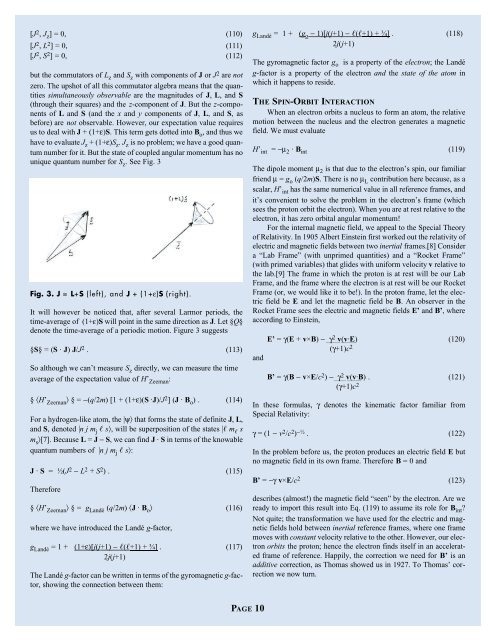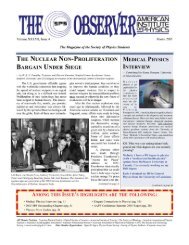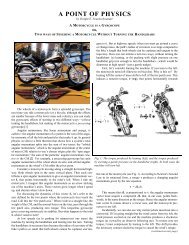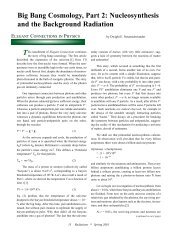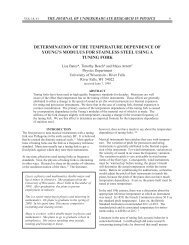Elegant Connections in Physics: Quantized Angular Momentum, 'g ...
Elegant Connections in Physics: Quantized Angular Momentum, 'g ...
Elegant Connections in Physics: Quantized Angular Momentum, 'g ...
Create successful ePaper yourself
Turn your PDF publications into a flip-book with our unique Google optimized e-Paper software.
[J 2 , J z ] = 0, (110)<br />
[J 2 , L 2 ] = 0, (111)<br />
[J 2 , S 2 ] = 0, (112)<br />
but the commutators of L z and S z with components of J or J 2 are not<br />
zero. The upshot of all this commutator algebra means that the quantities<br />
simultaneously observable are the magnitudes of J, L, and S<br />
(through their squares) and the z-component of J. But the z-components<br />
of L and S (and the x and y components of J, L, and S, as<br />
before) are not observable. However, our expectation value requires<br />
us to deal with J + (1+ε)S. This term gets dotted <strong>in</strong>to B o , and thus we<br />
have to evaluate J z + (1+ε)S z . J z is no problem; we have a good quantum<br />
number for it. But the state of coupled angular momentum has no<br />
unique quantum number for S z . See Fig. 3<br />
Fig. 3. J = L+S (left), and J + (1+ε)S (right).<br />
It will however be noticed that, after several Larmor periods, the<br />
time-average of (1+ε)S will po<strong>in</strong>t <strong>in</strong> the same direction as J. Let §Q§<br />
denote the time-average of a periodic motion. Figure 3 suggests<br />
§S§ = (S · J) J/J 2 . (113)<br />
So although we can’t measure S z directly, we can measure the time<br />
average of the expectation value of H’ Zeeman :<br />
§ ^H’ Zeeman & § = −(q/2m) [1 + (1+ε)(S ·J)/J 2 ] (J · B o ) . (114)<br />
For a hydrogen-like atom, the |ψ& that forms the state of def<strong>in</strong>ite J, L,<br />
and S, denoted |n j m j s&, will be superposition of the states | m s<br />
m s &[7]. Because L = J − S, we can f<strong>in</strong>d J · S <strong>in</strong> terms of the knowable<br />
quantum numbers of |n j m j s&:<br />
J · S = ½(J 2 − L 2 + S 2 ) . (115)<br />
Therefore<br />
§ ^H’ Zeeman & § = g Landé (q/2m) ^J · B o & (116)<br />
where we have <strong>in</strong>troduced the Landé g-factor,<br />
g Landé = 1 + (1+ε)[j(j+1) − (+1) + ¾] . (117)<br />
2j(j+1)<br />
The Landé g-factor can be written <strong>in</strong> terms of the gyromagnetic g-factor,<br />
show<strong>in</strong>g the connection between them:<br />
g Landé = 1 + (g o − 1)[j(j+1) − (+1) + ¾] . (118)<br />
2j(j+1)<br />
The gyromagnetic factor g o is a property of the electron; the Landé<br />
g-factor is a property of the electron and the state of the atom <strong>in</strong><br />
which it happens to reside.<br />
THE SPIN-ORBIT INTERACTION<br />
When an electron orbits a nucleus to form an atom, the relative<br />
motion between the nucleus and the electron generates a magnetic<br />
field. We must evaluate<br />
H’ <strong>in</strong>t = −m 2 · B <strong>in</strong>t (119)<br />
The dipole moment m 2 is that due to the electron’s sp<strong>in</strong>, our familiar<br />
friend m = g o (q/2m)S. There is no m L contribution here because, as a<br />
scalar, H’ <strong>in</strong>t has the same numerical value <strong>in</strong> all reference frames, and<br />
it’s convenient to solve the problem <strong>in</strong> the electron’s frame (which<br />
sees the proton orbit the electron). When you are at rest relative to the<br />
electron, it has zero orbital angular momentum!<br />
For the <strong>in</strong>ternal magnetic field, we appeal to the Special Theory<br />
of Relativity. In 1905 Albert E<strong>in</strong>ste<strong>in</strong> first worked out the relativity of<br />
electric and magnetic fields between two <strong>in</strong>ertial frames.[8] Consider<br />
a “Lab Frame” (with unprimed quantities) and a “Rocket Frame”<br />
(with primed variables) that glides with uniform velocity v relative to<br />
the lab.[9] The frame <strong>in</strong> which the proton is at rest will be our Lab<br />
Frame, and the frame where the electron is at rest will be our Rocket<br />
Frame (or, we would like it to be!). In the proton frame, let the electric<br />
field be E and let the magnetic field be B. An observer <strong>in</strong> the<br />
Rocket Frame sees the electric and magnetic fields E’ and B’, where<br />
accord<strong>in</strong>g to E<strong>in</strong>ste<strong>in</strong>,<br />
and<br />
E’ = γ(E + v×B) − γ 2 v(v·E) (120)<br />
_______ _______<br />
(γ+1)c 2<br />
B’ = γ(B − v×E/c 2 ) − γ 2 v(v·B) . (121)<br />
______ _______<br />
(γ+1)c 2<br />
In these formulas, γ denotes the k<strong>in</strong>ematic factor familiar from<br />
Special Relativity:<br />
γ = (1 − v 2 /c 2 ) −½ . (122)<br />
In the problem before us, the proton produces an electric field E but<br />
no magnetic field <strong>in</strong> its own frame. Therefore B = 0 and<br />
B’ = −γ v×E/c 2 (123)<br />
describes (almost!) the magnetic field “seen” by the electron. Are we<br />
ready to import this result <strong>in</strong>to Eq. (119) to assume its role for B <strong>in</strong>t ?<br />
Not quite; the transformation we have used for the electric and magnetic<br />
fields hold between <strong>in</strong>ertial reference frames, where one frame<br />
moves with constant velocity relative to the other. However, our electron<br />
orbits the proton; hence the electron f<strong>in</strong>ds itself <strong>in</strong> an accelerated<br />
frame of reference. Happily, the correction we need for B’ is an<br />
additive correction, as Thomas showed us <strong>in</strong> 1927. To Thomas’ correction<br />
we now turn.<br />
PAGE 10


